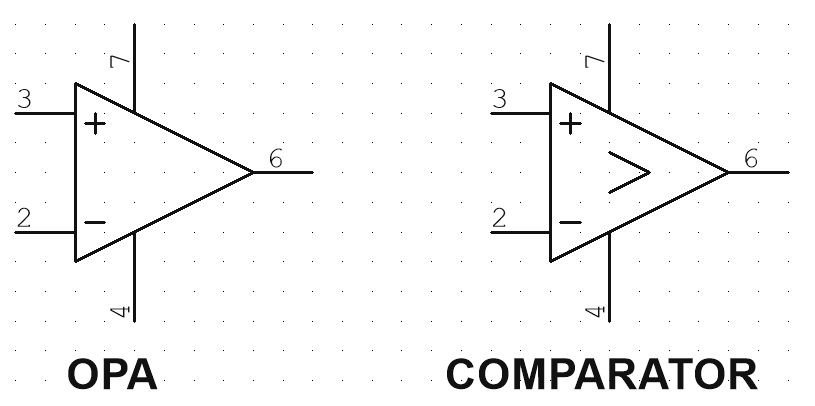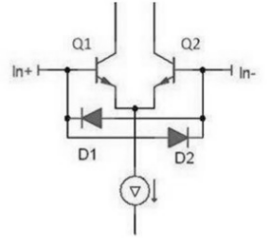Considerations for using op amps as comparators
 2022-01-27
2022-01-27The electrical symbols of the comparator and the operational amplifier are very similar. They are devices with two input terminals and one output terminal of inverting and non-inverting. The characteristics of low bias voltage, high gain and high common mode rejection ratio.

Figure 1 Operational amplifier and comparator
Difference between operational amplifier and comparator
①Output:
The comparator is generally a logic output, characterizing the level of the two input terminals. The output of most comparators on the market is compatible with TTL and CMOS, and the output of the comparator is always one of the positive and negative power rails. However, the output of the operational amplifier is an analog signal. Currently, the output of the CMOS type operational amplifier can generally achieve rail-to-rail output [1]. The output voltage signal of the operational amplifier can be any value close to the positive and negative power rails. The op amp can be used as a comparator if the output dynamic range of the operational amplifier does not exceed the power supply rails of the back-end logic circuit.
When the op amp is used as a comparator, the output is a push-pull architecture; the comparator can be made as a push-pull architecture or as an open-drain output architecture.
②Speed:
The comparator is suitable for open-loop systems and works under high-speed conditions and is usually relatively stable. The op amp may saturate when overdriven, making the recovery speed relatively slow, and the comparator's overload recovery time is short.
③ Input considerations:
Many operational amplifiers have built-in protection circuits to prevent large voltages from damaging the chip. When a large differential voltage is input, the input stage of many operational amplifiers will be abnormal, because the differential input voltage range of the operational amplifier is usually limited.

Figure 2 The internal input protection circuit of the op amp
The common-mode input voltage range of the non-rail-to-rail op amp cannot reach the positive power rail; the comparator supports the positive power rail.
Application scenarios where the op amp is used as a comparator
Op amps and comparators have many similar parameters. It is convenient to choose an op amp to replace the comparator in applications that require low offset voltage, low offset current, and high common-mode rejection.
Op amps generally have single op amp, dual op amp and quad op amp packages. The op amp is used as a comparator, and a double op amp or four op amps can complete the function of signal amplification and comparison. Whether in terms of convenience, cost or circuit board size, there will be more advantages.
Disadvantages of op amps as comparators
From a dialectical point of view, if there are advantages, there must be disadvantages. In the previous differences, we have already mentioned the difference in the speed of the op amp and the comparator. Therefore, when the op amp is used as a comparator, it is necessary to focus on speed, differential input voltage range and whether the amplifier output is overloaded.
Cautions for op amps as comparators
①Power supply:
If the logic and the operational amplifier share the same power supply, the rail-to-rail operational amplifier can drive CMOS and TTL logic, but if the operational amplifier and the logic circuit do not share the power supply, additional interface circuits are required.
②Input impedance and bias current:
When the op amp is used as a comparator, it must first meet the high input impedance condition. The input impedance of voltage feedback operational amplifiers such as CMOS op amps is in the megohm level, which satisfies the application. For current feedback (transconductance) operational amplifiers, the inverting input has a very low impedance and cannot be used as a comparator.
③ Differential input characteristics:
The original design of the operational amplifier is to cooperate with negative feedback to reduce the differential input as much as possible. In specific applications, it should be considered in combination with the differential input voltage actually required and the maximum differential input voltage that the op amp can actually provide.
④Common mode input characteristics:
For the old-fashioned FET-type input operational amplifier, when the input exceeds the allowable common-mode voltage range of the device, phase reversal will occur. At present, the op amps produced by various manufacturers use various means to try not to allow the op amp to reverse its phase. If the actual common-mode voltage range exceeds the input common-mode voltage range allowed by the op amp, actual verification is required to confirm normal operation.
⑤ Stability:
Since the op amp used as a comparator has no negative feedback externally, the open-loop gain is very high. Therefore, the parasitic capacitance of the PCB and the impedance of the non-inverting input terminal to ground may cause the output oscillation of the amplifier, which should be considered in the design.








